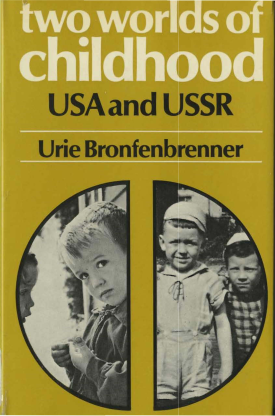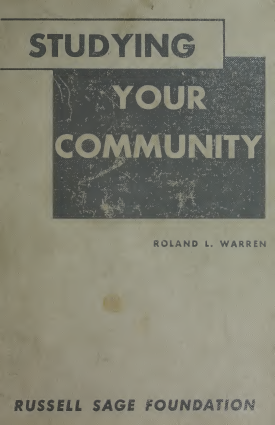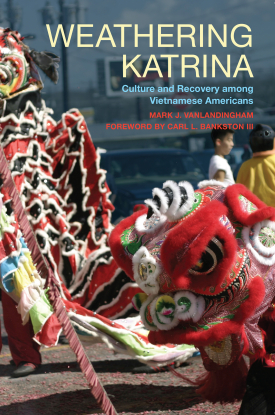
Weathering Katrina
About This Book
“Weathering Katrina is a very thoughtful and elegantly executed monograph by a master of the craft. It is social science at its best.”
— Kai Erikson, William R. Kenan, Jr. Professor Emeritus of Sociology and American Studies, Yale University
“Mark VanLandingham’s book, Weathering Katrina, tells a fascinating story of how the Vietnamese community in New Orleans East survived a major natural disaster and thrived afterward. It makes a significant contribution to the literature on disasters, community resilience, and ethnic culture.”
—Min Zhou, professor of sociology and Asian American studies, University of California, Los Angeles
In 2005, Hurricane Katrina devastated New Orleans. The principal Vietnamese-American enclave was a remote, low-income area that flooded badly. Many residents arrived decades earlier as refugees from the Vietnam War and were marginally fluent in English. Yet, despite these poor odds of success, the Vietnamese made a surprisingly strong comeback in the wake of the flood. In Weathering Katrina, public health scholar Mark VanLandingham analyzes their path to recovery, and examines the extent to which culture helped them cope during this crisis.
Contrasting his longitudinal survey data and qualitative interviews of Vietnamese residents with the work of other research teams, VanLandingham finds that on the principal measures of disaster recovery—housing stability, economic stability, health, and social adaptation—the Vietnamese community fared better than other communities. By Katrina’s one-year anniversary, almost 90 percent of the Vietnamese had returned to their neighborhood, higher than the rate of return for either blacks or whites. They also showed much lower rates of post-traumatic stress disorder than other groups. And by the second year after the flood, the employment rate for the Vietnamese had returned to its pre-Katrina level.
While some commentators initially attributed this resilience to fairly simple explanations such as strong leadership or to a set of vague cultural strengths characteristic of the Vietnamese and other “model minorities”, VanLandingham shows that in fact it was a broad set of factors that fostered their rapid recovery. Many of these factors had little to do with culture. First, these immigrants were highly selected—those who settled in New Orleans enjoyed higher human capital than those who stayed in Vietnam. Also, as a small, tightly knit community, the New Orleans Vietnamese could efficiently pass on information about job leads, business prospects, and other opportunities to one another. Finally, they had access to a number of special programs that were intended to facilitate recovery among immigrants, and enjoyed a positive social image both in New Orleans and across the U.S., which motivated many people and charities to offer the community additional resources. But culture—which VanLandingham is careful to define and delimit—was important, too. A shared history of overcoming previous challenges—and a powerful set of narratives that describe these successes; a shared set of perspectives or frames for interpreting events; and a shared sense of symbolic boundaries that distinguish them from broader society are important elements of culture that provided the Vietnamese with some strong advantages in the post-Katrina environment.
By carefully defining and disentangling the elements that enabled the swift recovery of the Vietnamese in New Orleans, Weathering Katrina enriches our understanding of this understudied immigrant community and of why some groups fare better than others after a major catastrophe like Katrina.
MARK J. VANLANDINGHAM is the Thomas C. Keller Professor at the Tulane University School of Public Health and Tropical Medicine.
RSF Journal
View Book Series
Sign Up For Our Mailing List
Apply For Funding
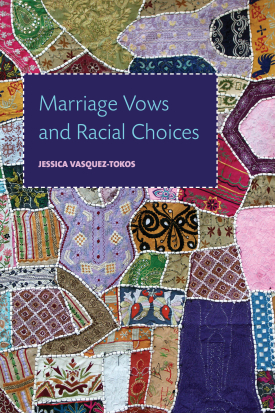
Marriage Vows and Racial Choices
About This Book
“If marriage patterns indicate the durability of the color line, Marriage Vows and Racial Choices is a rich account of how the color line shapes the experience of marriage. With lucid prose, Jessica Vasquez-Tokos goes inside the lives of Latina wives and Latino husbands to show how race colors whom they marry, how they stay married, and how they raise children. Demography is destiny, and Marriage Vows and Racial Choices is a must read for anyone who hopes to understand how that destiny is unfolding.”
—Tomás R. Jiménez, associate professor of sociology, Stanford University
“Jessica Vasquez-Tokos’s key contribution in this important new book is to open a black box inside theories of assimilation by illuminating how people actually make their marriage choices. Marriage Vows and Racial Choices details how race and ethnicity, generation, and gender ideologies and images about them play into people’s decisions on whom to marry. A strong empirical scientist, she follows her data to unanticipated places, deepening our understanding of immigration and contemporary America and reframing the debate.”
—Robert C. Smith, professor of sociology, immigration studies, and public affairs, Austin W. Marxe School of Public and International Affairs, Baruch College and CUNY Graduate Center
Choosing whom to marry involves more than emotion, as racial politics, cultural mores, and local demographics all shape romantic choices. In Marriage Vows and Racial Choices, sociologist Jessica Vasquez-Tokos explores the decisions of Latinos who marry either within or outside of their racial and ethnic groups. Drawing from in-depth interviews with nearly fifty couples, she examines their marital choices and how these unions influence their identities as Americans.
Vasquez-Tokos finds that their experiences in childhood, adolescence, and young adulthood shape their perceptions of race, which in turn influence their romantic expectations. Most Latinos marry other Latinos, but those who intermarry tend to marry whites. She finds that some Latina women who had domineering fathers assumed that most Latino men shared this trait and gravitated toward white men who differed from their fathers. Other Latina respondents who married white men fused ideas of race and class and perceived whites as higher status and considered themselves to be “marrying up.” Latinos who married non-Latino minorities—African Americans, Asian Americans, and Native Americans—often sought out non-white partners because they shared similar experiences of racial marginalization. Latinos who married Latinos of a different national origin expressed a desire for shared cultural commonalities with their partners, but—like those who married whites—often associated their own national-origin groups with oppressive gender roles.
Vasquez-Tokos also investigates how racial and cultural identities are maintained or altered for the respondents’ children. Within Latino-white marriages, biculturalism—in contrast with Latinos adopting a white “American” identity—is likely to emerge. For instance, white women who married Latino men often embraced aspects of Latino culture and passed it along to their children. Yet, for these children, upholding Latino cultural ties depended on their proximity to other Latinos, particularly extended family members. Both location and family relationships shape how parents and children from interracial families understand themselves culturally.
As interracial marriages become more common, Marriage Vows and Racial Choices shows how race, gender, and class influence our marital choices and personal lives.
JESSICA VASQUEZ-TOKOS is associate professor of sociology at the University of Oregon.
RSF Journal
View Book Series
Sign Up For Our Mailing List
Apply For Funding
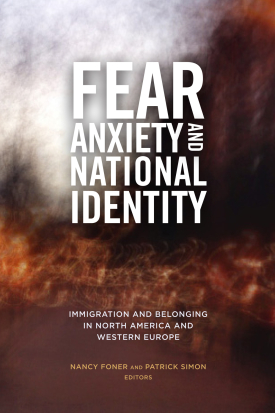
Fear, Anxiety, and National Identity
About This Book
Western European countries such as Germany, the Netherlands, and the United Kingdom have witnessed a significant increase in Muslim immigrants, which has given rise to nativist groups that question their belonging. Contributors Thomas Faist and Christian Ulbricht discuss how German politicians have implicitly compared the purported “backward” values of Muslim immigrants with the German idea of Leitkultur, or a society that values civil liberties and human rights, reinforcing the symbolic exclusion of Muslim immigrants. Similarly, Marieke Slootman and Jan Willem Duyvendak find that in the Netherlands, the conception of citizenship has shifted to focus less on political rights and duties and more on cultural norms and values. In this context, Turkish and Moroccan Muslim immigrants face increasing pressure to adopt “Dutch” culture, yet are simultaneously portrayed as having regressive views on gender and sexuality that make them unable to assimilate.
Religion is less of a barrier to immigrants’ inclusion in the United States, where instead undocumented status drives much of the political and social marginalization of immigrants. As Mary C. Waters and Philip Kasinitz note, undocumented immigrants in the United States. are ineligible for the services and freedoms that citizens take for granted and often live in fear of detention and deportation. Yet, as Irene Bloemraad points out, Americans’ conception of national identity expanded to be more inclusive of immigrants and their children with political mobilization and changes in law, institutions, and culture in the wake of the Civil Rights Movement. Canadians’ views also dramatically expanded in recent decades, with multiculturalism now an important part of their national identity, in contrast to Europeans’ fear that diversity undermines national solidarity.
With immigration to North America and Western Europe a continuing reality, each region will have to confront anti-immigrant sentiments that create barriers for and threaten the inclusion of newcomers. Fear, Anxiety, and National Identity investigates the multifaceted connections among immigration, belonging, and citizenship, and provides new ways of thinking about national identity.
NANCY FONER is Distinguished Professor of Sociology at Hunter College and the Graduate Center of the City University of New York.
PATRICK SIMON is Director of Research at the Institut national d’études démographiques (National Institute for Demographic Studies).
CONTRIBUTORS: Irene Bloemraad, Jan Willem Duyvendak, Thomas Faist, Nancy Foner, Gary Gerstle, Philip Kasinitz, Nasar Meer, Tariq Modood, Deborah J. Schildkraut, Patrick Simon, Marieke Slootman, Varun Uberoi, Christian Ulbricht, Mary C. Waters
Fear, Anxiety, and National Identity: Immigration and Belonging in North America and Western Europe
RSF Journal
View Book Series
Sign Up For Our Mailing List
Apply For Funding
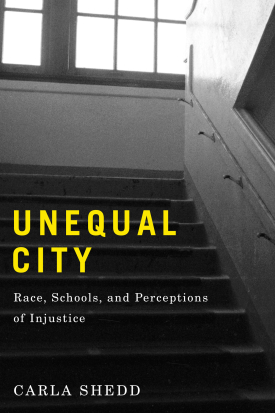
Unequal City
About This Book
Winner of the 2016 C. Wright Mills Award from the Society for the Study of Social Problems
Winner of the 2016 Distinguished Contribution to Scholarship Book Award Presented by the American Sociological Association's Section on Race, Gender, and Class
Honorable Mention, 2017 Outstanding Book Award from the Inequality, Poverty, and Mobility Section of the American Sociological Association
“Unequal City is a revelatory study that shows and tells how inner city young people struggle to acquire a decent education. It powerfully describes the everyday challenges these students face—illuminating how they navigate school and their local communities and the way they confront what too often holds them back. This book should be required reading for anyone who wants to understand the relationship between inequality and urban education.”
—Elijah Anderson, William K. Lanman, Jr. Professor of Sociology, Yale University
“Carla Shedd has written an important book about how race and place shape the experiences of young people in Chicago. Unequal City stands out for many reasons, but most importantly for its empirical richness. Shedd has amassed amazing data and uses both quantitative and qualitative methods to amplify the voices of young people. If you want to understand what young people think about such topics as the police, schools, and in-equality, you should read this book. It is a timely and insightful book.”
–Cathy Cohen, David and Mary Winton Green Professor of Political Science, University of Chicago
Chicago has long struggled with racial residential segregation, high rates of poverty, and deepening class stratification, and it can be a challenging place for adolescents to grow up. Unequal City examines the ways in which Chicago’s most vulnerable residents navigate their neighborhoods, life opportunities, and encounters with the law. In this pioneering analysis of the intersection of race, place, and opportunity, sociologist and criminal justice expert Carla Shedd illuminates how schools either reinforce or ameliorate the social inequalities that shape the worlds of these adolescents.
Shedd draws from an array of data and in-depth interviews with Chicago youth to offer new insight into this understudied group. Focusing on four public high schools with differing student bodies, Shedd reveals how the predominantly low-income African American students at one school encounter obstacles their more affluent, white counterparts on the other side of the city do not face. Teens often travel long distances to attend school which, due to Chicago’s segregated and highly unequal neighborhoods, can involve crossing class, race, and gang lines. As Shedd explains, the disadvantaged teens who traverse these boundaries daily develop a keen “perception of injustice,” or the recognition that their economic and educational opportunities are restricted by their place in the social hierarchy.
Adolescents’ worldviews are also influenced by encounters with law enforcement while traveling to school and during school hours. Shedd tracks the rise of metal detectors, surveillance cameras, and pat-downs at certain Chicago schools. Along with police procedures like stop-and-frisk, these prison-like practices lead to distrust of authority and feelings of powerlessness among the adolescents who experience mistreatment either firsthand or vicariously. Shedd finds that the racial composition of the student body profoundly shapes students’ perceptions of injustice. The more diverse a school is, the more likely its students of color will recognize whether they are subject to discriminatory treatment. By contrast, African American and Hispanic youth whose schools and neighborhoods are both highly segregated and highly policed are less likely to understand their individual and group disadvantage due to their lack of exposure to youth of differing backgrounds.
CARLA SHEDD is assistant professor of sociology and African American studies at Columbia University.
RSF Journal
View Book Series
Sign Up For Our Mailing List
Apply For Funding
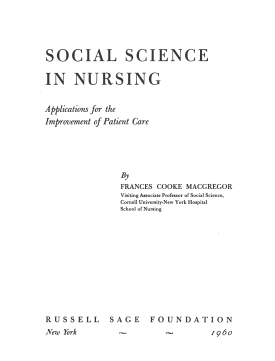
Social Science in Nursing
About This Book
Social Science in Nursing was the product of a three year project examining the application of the social sciences to nursing, conducted at the Cornell University-New York Hospital School of Nursing.
FRANCES COOK MACGREGOR was visiting associate professor of social science at Cornell University-New York Hospital School of Nursing.
Download
RSF Journal
View Book Series
Sign Up For Our Mailing List
Apply For Funding
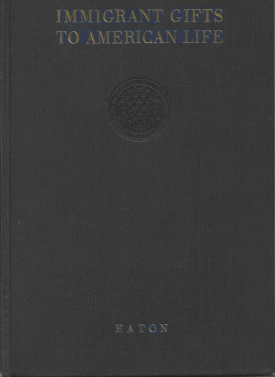
Immigrant Gifts to American Life
About This Book
Immigrant Gifts to American Life, published in 1932, describes the purpose and content of the Buffalo Exhibition and other similar expositions. The Buffalo Exhibition was a public show of the arts and skills foreigners have brought and contributed to in the United States, under the direction of Allen H. Eaton, author of this book and at that time field secretary of the American Federation of Arts. They utilized a common interest in the aesthetic values men live by to promote a better understanding of social and civic values.
ALLEN H. EATON, Department of Surveys and Exhibits, Russell Sage Foundation
Download
RSF Journal
View Book Series
Sign Up For Our Mailing List
Apply For Funding
About This Book
Two Worlds of Childhood is a cross-cultural study of child rearing and education in the U.S. and the Soviet Union, published in 1970. Bronfenbrenner conducted research in the Soviet Union to study child rearing in the family and collective settings.
URIE BRONFENBRENNER was professor of Psychology and of Child Development and Family Studies at Cornell University, and one of the founders of the Head Start Program.
Download
RSF Journal
View Book Series
Sign Up For Our Mailing List
Apply For Funding
About This Book
This book, published in 1955, is a successor to Joanna C. Colcord's Your Community: Its Provision for Health, Education, Safety, and Welfare, published by the Russell Sage Foundation in 1939. It is designed as a broadly conceived working manual of community study aimed at not just social workers, like its predecessor, but a more varied group of citizens. It details procedures for conducting the survey, both in its organizational and methodological aspects.
ROLAND L. WARREN was professor of sociology at Alfred University.
Download
RSF Journal
View Book Series
Sign Up For Our Mailing List
Apply For Funding
Pagination
- Previous page
- Page 9
- Next page

